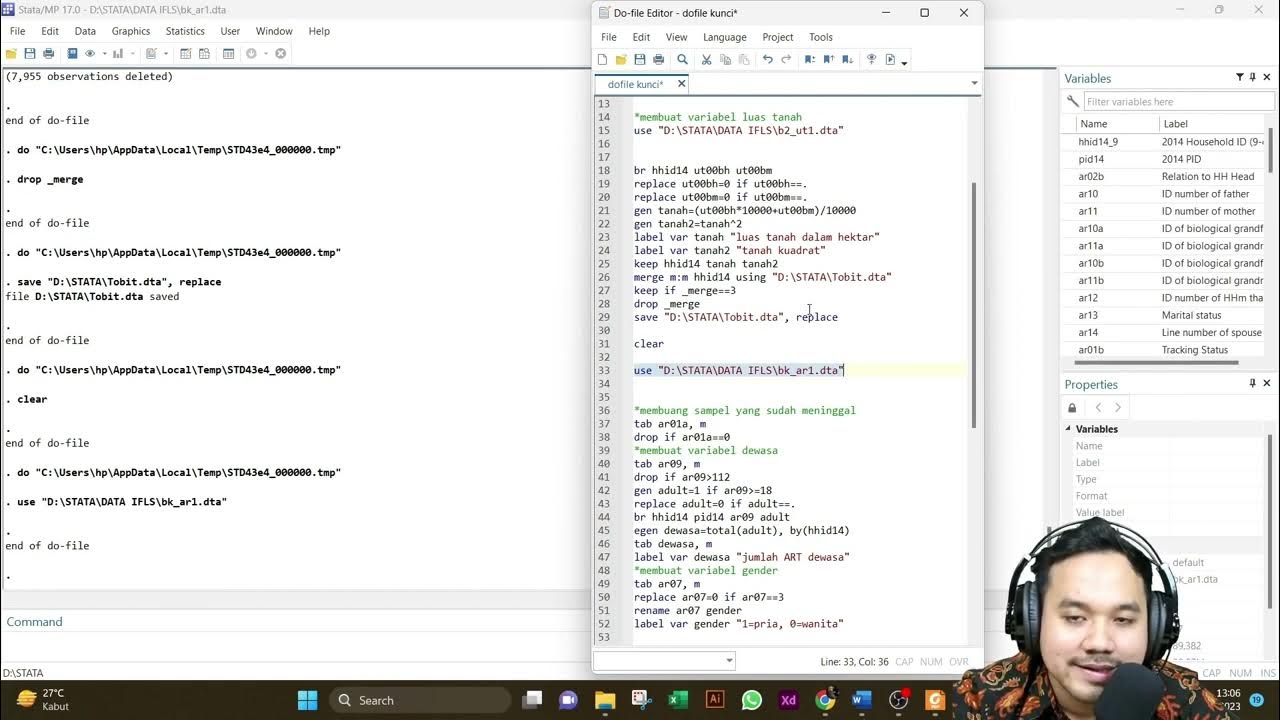Regresi Resisten (Garis Resisten)
Summary
TLDRThis video discusses exploratory data analysis, specifically focusing on regression analysis. It introduces regression techniques, such as linear and resistant regression, emphasizing the use of resistant regression when dealing with outliers or extreme data points. The process involves sorting data, dividing it into three parts, finding medians, and calculating coefficients to form the regression equation. The presenter explains how resistant regression is beneficial for models affected by outliers, providing an example using a dataset to illustrate the steps involved. The video aims to equip viewers with the tools to handle data with extreme variations using resistant regression.
Takeaways
- 😀 The script begins with a greeting in Arabic, wishing well-being and the protection of Allah for the audience.
- 😀 The focus of the discussion is on regression analysis, particularly exploring regression techniques, and how to analyze relationships between variables.
- 😀 In regression analysis, there are two key variables: the independent variable (X) and the dependent variable (Y). Understanding their roles is crucial.
- 😀 The independent variable (X) influences the dependent variable (Y), while Y is affected by X.
- 😀 Before conducting regression analysis, creating a scatter plot between X and Y is essential to visualize their relationship.
- 😀 A regression plot can reveal different relationships: linear, non-linear, or no correlation at all.
- 😀 Regression analysis can be impacted by outliers, or extreme data points, which could skew the results.
- 😀 Resistant regression is introduced as a technique to handle extreme data points or outliers, ensuring that the results aren't overly influenced by them.
- 😀 Resistant regression focuses on using medians rather than means, making it more robust in the presence of outliers.
- 😀 The process of resistant regression includes sorting data, dividing it into three groups, and calculating the medians of each group to determine the regression coefficients.
- 😀 A practical example is provided, illustrating how data is organized, medians are calculated, and how resistant regression is applied to obtain a more accurate model despite outliers.
Q & A
What is the purpose of regression analysis?
-Regression analysis is a statistical technique used to model the relationship between two or more quantitative variables, helping to understand the form of their connection and predict one variable based on the other.
What are the two main types of variables in regression analysis?
-In regression analysis, there are two main types of variables: the independent variable (X), which influences the dependent variable, and the dependent variable (Y), which is influenced by the independent variable.
What is the difference between independent and dependent variables?
-The independent variable (X) is the one that influences or predicts the value of another variable. The dependent variable (Y) is the one that is predicted or affected by changes in the independent variable.
What is a scatter plot, and why is it important in regression analysis?
-A scatter plot is a graphical representation of data points, showing the relationship between the independent and dependent variables. It's crucial in regression analysis because it helps visualize the potential linear or non-linear relationship between variables.
What does resistant regression aim to address?
-Resistant regression is used to handle datasets with outliers or extreme points, ensuring that the regression model is not unduly influenced by these outliers, unlike regular linear regression models.
How does resistant regression differ from regular linear regression?
-In regular linear regression, outliers can heavily influence the resulting regression line, while in resistant regression, outliers have a minimal impact, as it uses median values rather than averages, making it more robust to extreme data points.
What are the steps involved in performing resistant regression?
-The steps include sorting the data based on the independent variable, dividing the data into three groups (lower, middle, and upper), finding the median for each group, and then calculating the regression coefficients using these medians.
How do you determine the three groups for resistant regression?
-To divide the data into three groups, the data is sorted by the independent variable, and the groups are created with roughly an equal number of observations, ensuring the upper and lower thirds each contain at most one-third of the total data points.
What role do outliers play in resistant regression?
-In resistant regression, outliers are accounted for by using the median instead of the mean, reducing their effect on the regression line and allowing for a more reliable model when extreme values are present.
What is the formula for calculating the regression coefficient (B) in resistant regression?
-The regression coefficient (B) is calculated using the formula: B = (Y_median_upper - Y_median_lower) / (X_median_upper - X_median_lower), where the medians of the upper and lower groups for both X and Y are used.
Outlines

This section is available to paid users only. Please upgrade to access this part.
Upgrade NowMindmap

This section is available to paid users only. Please upgrade to access this part.
Upgrade NowKeywords

This section is available to paid users only. Please upgrade to access this part.
Upgrade NowHighlights

This section is available to paid users only. Please upgrade to access this part.
Upgrade NowTranscripts

This section is available to paid users only. Please upgrade to access this part.
Upgrade Now5.0 / 5 (0 votes)





